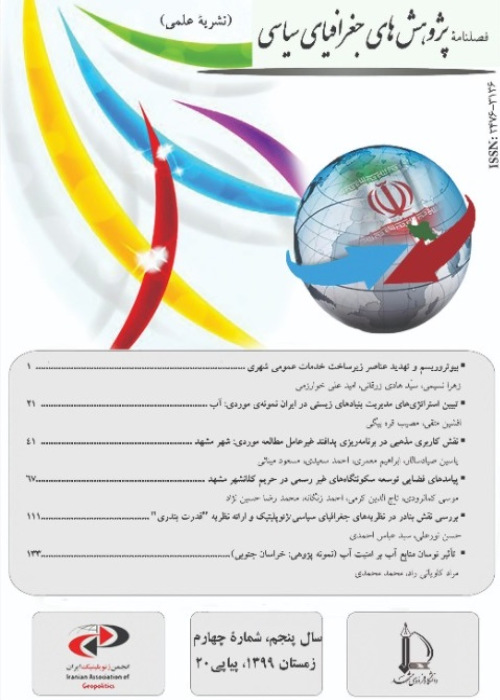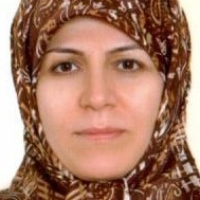Political organization of city space from distribution of polling stations’ point of view: Case study: Eyvan City
The political organization of space as an organizing process of a part of the Earth limited by boundary for playing political roles has main purposes; one of them is facilitating people polling and citizens’ political turn-out which is realized through locating polling stations in city space. Therefore, voting boxes should be located regarding fair scientific principles and methods. It should be in line with improving citizens’ satisfaction and consequently their maximum turn-out. Otherwise, failure in this important affair leads to decrease citizens’ turn-out in elections. Undoubtedly, election executive boards have an important role in the above mentioned process. The main question of this article is what pattern of distribution of polling stations is followed in Eyvan city (one of the cities in the northern constituency of Ilam Province) and if people are satisfied with the location of polling stations in the previous elections. Review of literature Political organization of city space as a location of national and local election is done through locating voting branches. Planning for locating these branches is responsibility of election executive boards and optimal dispersion of these branches can affect the citizens’ participation in elections. Population density is the most important factor in this matter. Other considered factors are as follows in order of importance: Eligible places for polling stations, Polling stations distance from main ways, Accessibility of polling stations to security and services centers. Of written articles the followings can be mentioned. Special place Analysis of voting box in 15th area of Tehran with help of GIS (Nazarian et. al, 2011), Distance traveled to polling locations: Are travel costs imposed equally on party members (Joslyn et al, 2018).
In terms of purpose, this study is functional and in terms of identity and general method it is analytical- descriptive. Data gathering was done through field (questioner) and library method. For data description, descriptive statistics and for data analysis GIS software, hierarchical analysis (AHP), expert Choice software and SPSS (one- way T-test) have been used. Statistical population is people over 18 years old (eligible people for voting). Sample size is 380 people computed by using Cochran formula and multi stage cluster. In this study researcher- made questioner has been used that its validity is formal and its reliability which is 0.84 has been calculated based on Cranach’s alpha.
1. Weighing the criteria: (effective factors on polling stations). In order to weigh through AHP method, the first criteria (effective factors on polling stations distribution) were compared two by two. Then Expert Choice software was used to compute the weight of each criterion. This software has been designed for analyzing multivariable Problems by using hierarchical analytical process (AHP). The weight of criteria calculated by Expert Choice software has been shown in the following table. Table 1. Weight of criteria criterion weight Incompatibility coefficient Population density 0.44 0.12 :incompatibility less than 1% which shows compatibility between binary matrix coefficients Accessibility of polling stations to security and services centers 0.037 Polling stations distance from main ways 0.107 Infrastructure (eligible places for polling stations) 0.415 2. Preparation and layer integration In decision making process, the optimal area is a span which has the best condition for studying identification factors and criteria. In this stage, the conditions should be provided so that the summing of all effective indices is possible. Fuzzy logic is elective method in order to value subject layers. In this method, the studied area is valued by zero and one interval in each layer. In order to integrate resulted layers using obtained weights, simple mass weighting method was used. The results of integration are shown in the following features. Potential area for polling stations: population density area T 0.44+ infrastructure area T 0.415+ stations distance from main ways T 0.107+ station distance area from security- service centers T 0.37. Map 2. matching the proposed points with potential area Map 1. Potential area for polling stations 3. Studying eligible places of polling stations and determining suggested stations In this stage all eligible places for polling stations in the city were studied and eligible places were determined. 22 out of 26 cases have adapted with optimal area (Map3). In GIS software population and the radius of each polling station was determined by using menus of Geoprocessing (Buffer, clip) and Selection (selection by location), such that stations have minimum overlap and citizens had maximum accessibility to polling boxes in the way that it leads to prevent over-crowding. Based on such pattern, the maximum citizens’ satisfaction with polling boxes location have been provided and formation of more voting holes (long distance to polling stations) has been prevented (Map3), while in the previous elections, polling stations location have been determined approximately and polling stations with high overlap and their distribution didn’t follow special pattern (Map 4). Map 3. Suggested pattern for polling stations’ distribution of parliament election in 2020 Map 4. Map of polling stations’ distribution in president elections in 2018 4. Findings and field analyses Suggested interval of polling stations for 97% of respondents was less than 250 meters which it has been observed in suggested pattern for20 polling boxes (out of 25 boxes) while in previous elections, the 250 meter distance was observed from 65% people’s point of view. 60% of respondents have preferred establishment of polling stations in educational and official places over masques. Also, scores of items were combined separately and were test by T-Test statistic for assessing satisfaction from polling stations (table).Using this test, both the significance of the indices and difference from the mean are determined. In this way, comparing average level of variable impact of satisfaction of polling stations stations which is 2.6 with average validated level of impact which is 3 and also regarding computed level of significance which is determiner of a numbers over 5%, shows that there was no satisfaction with polling stations location in the previous elections. Table 2. The result of T-Test variable number mean degree of freedom T-statistics Standard deviation Significance level Mean difference satisfaction 380 2.6 0.79 1.3 379 0.06 -0.40 .
Findings show that there was no satisfaction with distribution of polling stations in the previous elections and location of boxes hasn’t followed any special pattern, in the way that a few stations have been established in some densely populated areas and vice versa. Accordingly, potential area is determined by using related models for establishing polling stations and suggested pattern has been designed in GIS based on population density parameters (above 18 years) accessibility and infrastructure (existence of eligible places for polling). In this pattern, polling stations had minimum overlap, radius coverage and certain population and prevention of formation of voting holes (citizens’ accessibility to voting stations) is facilitated. Establishing stations for department of natural resources, 17 Sharivar school, Imam Hasan Mosque, Samen Mosque, and Payamenor and deleting Hoseinieh Rashidi, kaosar, Sepideh and Hafez Gaireentefaee and relocation of seven stations (Chamran, Imam Jafare sadeg, Dr Hesabi , valie asar Mosque, Hazrate Masome(Ateferashidi), Jame Mosque, and shahid Mottahari) has been suggested in the new pattern.
- حق عضویت دریافتی صرف حمایت از نشریات عضو و نگهداری، تکمیل و توسعه مگیران میشود.
- پرداخت حق اشتراک و دانلود مقالات اجازه بازنشر آن در سایر رسانههای چاپی و دیجیتال را به کاربر نمیدهد.



